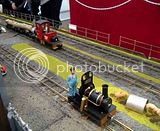- Joined
- Jan 4, 2011
- Messages
- 1,334
- Reaction score
- 344
I am starting to think that I am just stupid. I have been building a Cracker Locomotive which is supposed to be simple but I just cannot get a burner to work. I have tried the one shown on the Glaser plans and cannot get it to work. I have looked at threads about others building a poker burner and have tried to build the same thing. The burner flue is 1/2" copper tube which is about 5/8" OD. The burner tube is 1/4" OD copper. I have tried burner tubes 1 1/2" long and 3" long. I have cut slots and tried burner holes from 1/16 dia to 3/16 dia. I have tried 2 holes to 10 holes. I have tried air inlet holes at the nozzle from 1/16 dia to 3/16" dia. I have tried putting stainless screen around the burner. I can get a relatively blue flame outside of the flue but as soon as I insert it into the flue I just get yellow flame out of the end with no burning at the burner tube. I am sure that I am missing something but I am running out of things to try.
I also just noticed that the butane tank I have built does not seem to hold much butane. It is 5/8 OD x 1 1/2" long with a Ronson fill valve. It only seems to burn less than a minute before it runs out of butane. I am not sure if that is another problem or part of the burner problem.
Gordon
I also just noticed that the butane tank I have built does not seem to hold much butane. It is 5/8 OD x 1 1/2" long with a Ronson fill valve. It only seems to burn less than a minute before it runs out of butane. I am not sure if that is another problem or part of the burner problem.
Gordon












